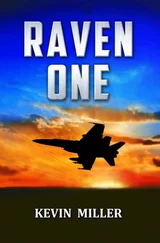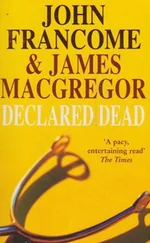Stunned, Wilson waited for the cockpit to return to life and realized with horror that it wasn’t happening this time. Fear burst into his brain as he yanked back on the stick. Did they hit me? Another lightning strike? He was under five g’s and the airplane’s nose was moving up but not fast enough for Wilson. I’m in MECH! He was now in a black cockpit and struggled to recover from the dive in manual flight control mode. Using the cable and pulley backup system to fly the jet, his heavy jet, the goggles affixed to his helmet were his only sensor or instrument.
Wilson realized he still had his bombs attached and, knowing he was right over several enemy gun emplacements, he let off on the g and, in the darkness, found the EMERG JETT switch and pushed it. Nothing! As he turned to the right in his desperate flight to safety, he pushed it again and waited in vain for the familiar lurch of jettisoned bombs and fuel tanks. AAA rounds were all about him now, and he flicked on his gooseneck flashlight to see altitude on the cockpit backup display. Under 10,000 feet, his nose was breaking the horizon as the g pushed down on his goggles in his struggle to fly the airplane and escape with his life.
In frantic fear, Wilson cycled the battery switch to get basic electric power. Nothing! He cycled the number two generator in another vain attempt to restore power. With total electrical failure, the flashes from bomb impacts below him, the lightning behind him, and AAA whizzing by next to him produced eerie shadows in his dark — and quiet — cockpit. Now deep in the caldron of Dante’s Inferno, Wilson saw a Hornet pull off to his right a few thousand feet above him.
Fly the airplane. Wilson began to repeat to himself the first axiom of aviation, and, with his goggles, he could see the Columbus Channel — and safety — beckoning. Another Hornet — DCAG? — flew away high off his right. His ordnance was still attached, and repeated depressions of EMERG JETT were having no effect. Wilson sensed he was slow and shoved the throttles to MAX. On his steam gauge airspeed indicator he was doing 400 plus. He wanted to double that.
Wilson shot a glance over his right shoulder at San Ramón. In addition to the blinking of AAA guns, he could see clouds of smoke on the field from the numerous Slash hits. Breathing through his mouth, he concentrated on getting fast and maintaining a slight climb. Bright fireballs of AAA shot by him in groups of three and four, orderly trails from low to high. His body was tense, ready for impact.
He felt and heard the thud behind, on his right.
Terrified, Wilson twisted his body in the ejection seat to see what he could, pushing his helmet and goggles with his left hand to see over his wing. Through the narrow field of view of the goggles, he sensed flickering behind him. He then felt the airplane yaw right. Both were signs he had lost thrust on the right side.
Sonofabitch!
Squeezing the stick with his right hand, Wilson secured the right throttle with his left. He then reached across to lift the protective cover and punch the right fire light button. He now had to step on left rudder to keep the aircraft in balance and twisted his neck again to see if securing the right engine had had any affect. He still saw flickering from behind the right wing. That was evidence enough for him, and he pushed the fire extinguisher ready button and dropped the tailhook as part of the emergency action procedure he knew by rote memory. With zero electrical power, he didn’t know if any of it would work. Zero!
Río Salta, also sending streams of AAA skyward, was passing down his left side, and he figured he had about 20 miles to feet wet. He was flying. It had been over a minute since he had felt the impact and secured his engine, and he could navigate visually. He saw the faint outlines of more Hornets passing over him high to his right. Most of all, Wilson wanted to get feet wet, but he also wanted to tell them he was still flying. With his left hand, he unzipped the pocket on his vest and pulled out his CSEL survival radio, a brick-shaped radio with an attached battery and a collapsible antenna. He flicked it on and popped off one of his mask fittings to stuff the earpiece in his ear. He then realized they hadn’t briefed a discrete Combat SAR frequency! It was one of many items that had fallen through the cracks. He selected GUARD and transmitted, mindful that the Venezuelans could also monitor that frequency. Unsure about how long his jet could stay together, Wilson decided he had to let his wingmen know he was with them. He depressed the push-to-talk switch.
“Mayday. Mayday. Mayday. Slash one-one on GUARD. Still with you. Total electrical failure. Switching squadron tac.” Wilson only had to wait a few seconds for an answer, but it felt much longer as he struggled to fly his stricken jet toward the water.
“Roger, Slash one-one. Switching!” Wilson didn’t recognize the voice — maybe it was DCAG who, by his seniority, would run the CSAR as on-scene commander. But Wilson didn’t wait. He switched to A and began to punch in the squadron tactical frequency.
Without warning, his nose pitched up.
Wilson pushed the stick forward. Nothing! As the nose continued to rise higher and higher, he saw nothing ahead of him but the band of stars making up the Milky Way. He deflected the stick left. Nothing! In a panic, he jerked it back to the right. The stick was dead in his hand.
Now the jet, with its nose parked high, was in danger of stalling due to lack of airflow over the wings. With a burst of adrenalin, and his mind in overdrive, Wilson stomped on the left rudder pedal. The Hornet obeyed and yawed left, the nose knuckling down to the horizon. As the airplane fell through on its side, Wilson stomped on the right rudder to try and hold the nose steady in a shallow climb toward the coast. Although it was sluggish, the nose responded, and Wilson pulled the left throttle out of burner to hold the attitude. How he wished he could lose those bombs and tanks weighing down his jet!
The airplane rolled off to the right and full left rudder did not stop it, so he helped it along with full right rudder. When his jet rolled inverted and nose down, Wilson stood on the right rudder and reengaged the left blower to recover. The nose came back through to the horizon, and Wilson released the controls. He was heading toward another storm that sat off the port along the coast. He wasn’t sure he could roll away from it and hoped to stagger past using only rudder and differential power on his one operating engine.
With no pitch control, he had to keep the jet rolling, and with each roll he lost altitude. He was now in the low teens making progress toward the coast, and the storm.
* * *
Lieutenant Junior Grade Mark “Kid” Webb, the wide-eyed nugget flying Slash 34, Tail-End-Charlie, had a visual on Commander Wilson in Slash 11.
Low and to his left, he picked up the gray planform of a Hornet , lights out, rolling toward the coast. He figured the jet had to be Skipper Wilson, who the lead Slash division had reporting missing before the skipper came up on GUARD. Five miles from feet wet was good news, but it appeared the stricken aircraft was flying into a thunderstorm off to the north. The Slashes were clear of the heavy AAA over San Ramón, and the radar warning gear had also quieted down. He kept his eyes on the aircraft that was rolling in such an unusual manner. He noticed a small light on it — aft of the wing line from what he could tell — and sang out to the others.
“ Slash three-four has a visual on a Hornet , midnight. Heading east into that cell north of us.”
Читать дальше












